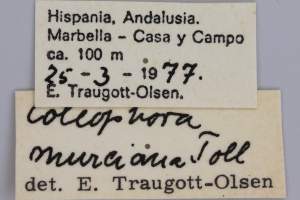2. Diagnose
2.1. Geschlecht nicht bestimmt
2.2. Genitalien
2.2.1. Männchen
3. Biologie
3.1. Falter
Tabell et al. (2023: 155) betonen zu den Imagines: "Males collected by JT were swarming in the morning between 7:00–7:30 (summer time), the female was detected in copula. Not a single adult was captured at night by light."
3.2. Nahrung der Raupe
- [Poaceae:] Avena sativa (Saat-Hafer)
- [Poaceae:] Hordeum vulgare (Kultur-Gerste)
- [Poaceae:] Hordeum murinum (Mäuse-Gerste)
- [Poaceae:] Bromus sterilis (Taube Trespe)
Coleophora perplexella gehört zu den als Raupe an Süßgräsern lebenden Arten. Baldizzone (2016) meldet: "The bionomics was partially described by Nel (2010), who studied the species in southern France. Eggs are probably directly deposited on leaves of Hordeum murinum L. and Bromus sterilis L. (Poaceae). The young larvae mine the leaves, hibernate and re-start feeding in the following spring, producing distinctive white mines which are 1.5 mm long and 2-3 mm wide. Pupation takes place inside the case attached to a support." Es handelt sich also um häufige Arten eher trockener Ruderalstellen.
Haouas et al. (2019) betonen, dass die Art bisher nie als landwirtschaftlicher Schädling galt, was sich aber mit der Einschleppung nach Tunesien geändert hat: Die Autoren zählten und errechneten dort im Dezember eine mittlere Dichte von 128 Raupen pro Quadratmeter Hafer-Feld, was ausreichte, den aufgekeimten Junghafer praktisch komplett zu zerstören. Auch in den anderen Probeflächen lag die Raupendichte nur wenig unter 100 Tiere pro Quadratmeter.
(Autor: Erwin Rennwald)
4. Weitere Informationen
4.1. Synonyme
- Coleophora murciana Toll, 1960 [synonymisiert von Baldizzone (2016)]
4.2. Taxonomie
Baldizzone (2016) stellte fest, dass die Typenserie von C. murciana aus zwei Arten besteht. Der männliche Holotypus ist konspezifisch mit C. perplexella, der weibliche Paratypus mit C. hiberica.
4.3. Faunistik
Die Art scheint - ganz anders als ihre auch in Mitteleuropa häufigen Wirtsgräser - auf den westlichen Mittelmeerraum beschränkt zu sein: Baldizzone (2016) nennt Portugal, Spanien, Süd-Frankreich, Sardinien - außerhalb Europas noch Algerien und Marokko.
Haouas et al. (2019) melden die Art erstmals aus Tunesien und erläutern: "Coleophora perplexella Toll, 1960 it is native of Spain and Portugal, but it has detected out of its origin area, and was found in Sardinia, Morocco and Algeria without its host plant being identified. Recently has been observed in France (Toulon) on Hordeum murinum L. and Bromus sterilis L. (Poaceae). However, it was never cited among the Tunisian entomofauna." Dabei melden die Autoren gleich massive landwirtschaftliche Schäden an Getreide in Tunesien.
4.4. Typenmaterial
Baldizzone (2016) untersuchte das Typenmaterial und stellte fest:
"Holotypus ♀: “Chiclana, 17-VII”; “PG |Gr. v. Toll No. 1674 ♀”; coll. Polish Academy of Sciences, Institute of Systematics and Evolution of Animals, Kraków, Poland."
Und zum Synonym Coleophora murciana ist bei ihm zu erfahren: "Holotypus ♂ : “Murcia”;“Präparat |No 440/ Gr. v. Toll”;“Coleophora/ murciana Toll | Gr. v. Toll det.”; “Holotypus”; “Museum für/ Naturkunde | Berlin | Altbestand”, coll. Zoologisches Museum der Humboldt- Universität Berlin, Germany."
(Autoren: Erwin Rennwald & Jürgen Rodeland)
4.5. Literatur
- Baldizzone, G. (2016): On the identity of Coleophora perplexella Toll, 1960 and C. murciana Toll, 1960. Contributions to the knowledge of Coleophoridae. CXXXIII (Lepidoptera: Coleophoridae). — SHILAP Revista de Lepidopterología 44 (173): 149-156 [PDF auf redalyc.org].
- Haouas, D., Baldizzone, G., Hamdi, A., Hafsi, C. & M. Ben-Hammouda (2019): Occurrence of new case-bearer on cereals, Coleophora perplexella Toll, 1960 (Lepidoptera: Coleophoridae). — SHILAP Revista de Lepidopterología, 47 (186): 251-259. [PDF auf redalyc.org]
- Nel, J. (2010): Sur la biologie de Coleophora perplexella Toll, 1960, das la Var (Lep. Coleophoridae). — Oreina 11: 4. [PDF auf oreina.org]
- Tabell, J., Kullberg, J., Mutanen, M., Tokár, Z. & P. Sihvonen (2023): New and little known Coleophora Hübner, 1822 species from Morocco. Part I. (Lepidoptera, Coleophoridae). — Zootaxa 5374 (2): 151–195. [Zum PDF auf mapress.com]
- Erstbeschreibung und Beschreibung als C. murciana: Toll, S. (1960): Studien über die Genitalien einiger Coleophoridae. XVI. (Lepidoptera). — Acta Zoologica Cracoviensia 5 (7): 249-310, pl. XXXV-LI [hier: 252] [PDF auf db.isez.pan.krakow.pl].




![Vorkommen in Frankreich (europäisches Territorium ohne Korsika) [Vandromme et al. (2020): Liste systématique et taxinomique des Lépidoptères de France]](/res/img/flag/fr.gif)
![Vorkommen in Spanien (Festland) [Vives Moreno A. (2014)]](/res/img/flag/es.gif)
![Vorkommen in Portugal (Festland) [Corley (2015): Lepidoptera of Continental Portugal]](/res/img/flag/pt.gif)
![Vorkommen auf Sardinien [Baldizzone et al. (1995): Checklist delle Specie della Fauna Italiana 83]](/res/img/flag/it-sar.png)
![Vorkommen in Marokko [Baldizzone (2003: 238) als C. murciana; Haouas et al. (2019); Tabell, Kullberg, Mutanen, Tokár & Sihvonen (2023)]](/res/img/flag/ma.gif)
![Vorkommen in Algerien [Baldizzone (2003: 238) als C. murciana; Haouas et al. (2019)]](/res/img/flag/dz.gif)
![Vorkommen in Tunesien [Haouas et al. (2019)]](/res/img/flag/tn.gif)




